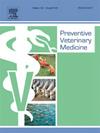饲喂标准饮食的幼犬和老年犬的流行病学和临床概况
IF 2.4
2区 农林科学
Q1 VETERINARY SCIENCES
引用次数: 0
摘要
本研究旨在探讨食用标准化饮食的狗在流行病学和临床参数方面与年龄有关的差异,重点关注与兽医从业人员相关的因素。研究共纳入 106 只狗,包括幼年(2-5 岁)和老年(≥8 岁)狗。流行病学数据通过问卷调查和兽医咨询收集,临床参数则通过体格检查和血液分析评估。与年轻的狗相比,老年狗不太活跃,更有可能住在家里,也更经常接受定期驱虫。与幼犬相比,它们也更倾向于食用从宠物店或超市购买的食物。临床评估显示,老年犬的血浆球蛋白和血小板较高,白蛋白较低,这与衰老引起的慢性低度炎症相符。肌肉减少、皮毛质量差和淋巴细胞数量减少在老年犬中也很突出,这可能分别反映了肌肉减少症、营养不良和免疫衰老。值得注意的是,以前喂食缺乏欧米伽-3 脂肪酸来源的狗,即使在过渡到含有鱼油的优质饮食四周后,血浆甘油三酯也会升高,这突出表明了长期饮食习惯的持久影响。这些发现强调了兽医对老年犬进行定期随访的重要性以及优质营养(包括欧米加-3 脂肪酸)的作用。通过确定关键的流行病学和临床差异,这项研究为兽医从业人员区分健康老龄化和病理老龄化提供了有价值的见解。本文章由计算机程序翻译,如有差异,请以英文原文为准。
Epidemiological and clinical profiles of young and senior dogs fed a standard diet
This study aimed to explore age-related differences in epidemiological and clinical parameters in dogs consuming a standardized diet, focusing on factors relevant to veterinary practitioners. A total of 106 dogs were included, comprising young (2–5 years) and senior (≥8 years) individuals. Epidemiological data were collected through questionnaires and veterinary consultations, while clinical parameters were assessed via physical examinations and blood analyses. Compared to younger dogs, senior dogs were less active, more likely to live in houses, and more frequently received regular deworming. They were also more likely to consume food purchased from pet stores or supermarkets compared to younger dogs. Clinical evaluations revealed that senior dogs had higher plasma globulin and platelets and lower albumin, consistent with chronic low-grade inflammation associated with aging. Muscle loss, poor coat quality, and reduced lymphocyte counts were also prominent in senior dogs, potentially reflecting sarcopenia, malnutrition, and immunosenescence, respectively. Notably, dogs previously fed diets lacking a source of omega-3 fatty acids exhibited elevated plasma triglycerides even after transitioning for four weeks to a premium diet containing fish oil, underscoring the lasting impact of long-term dietary habits. These findings highlight the importance of regular veterinary follow-ups for senior dogs and the role of high-quality nutrition, including sources of omega-3 fatty acids. By identifying key epidemiological and clinical differences, this study offers valuable insights to help veterinary practitioners distinguish between healthy and pathological aging.
求助全文
通过发布文献求助,成功后即可免费获取论文全文。
去求助
来源期刊

Preventive veterinary medicine
农林科学-兽医学
CiteScore
5.60
自引率
7.70%
发文量
184
审稿时长
3 months
期刊介绍:
Preventive Veterinary Medicine is one of the leading international resources for scientific reports on animal health programs and preventive veterinary medicine. The journal follows the guidelines for standardizing and strengthening the reporting of biomedical research which are available from the CONSORT, MOOSE, PRISMA, REFLECT, STARD, and STROBE statements. The journal focuses on:
Epidemiology of health events relevant to domestic and wild animals;
Economic impacts of epidemic and endemic animal and zoonotic diseases;
Latest methods and approaches in veterinary epidemiology;
Disease and infection control or eradication measures;
The "One Health" concept and the relationships between veterinary medicine, human health, animal-production systems, and the environment;
Development of new techniques in surveillance systems and diagnosis;
Evaluation and control of diseases in animal populations.
 求助内容:
求助内容: 应助结果提醒方式:
应助结果提醒方式:


